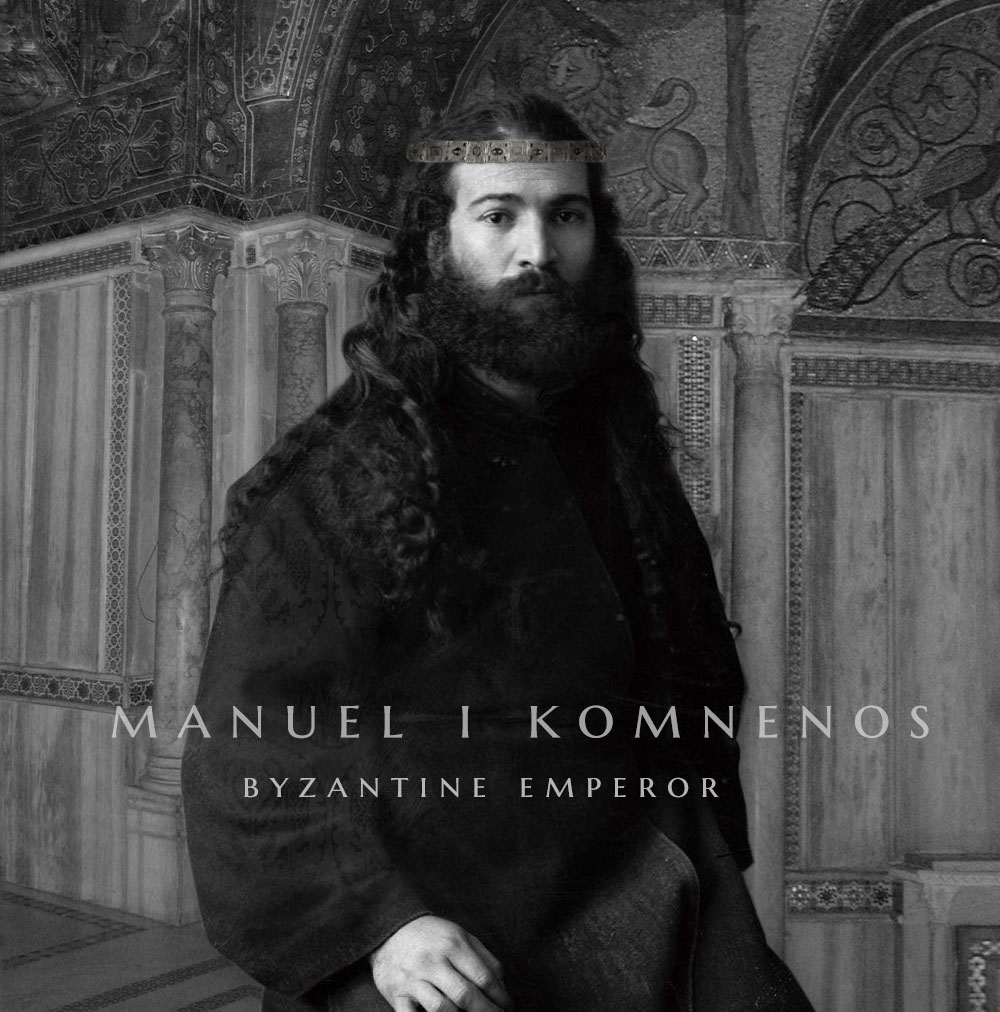 There were two areas within the walls of the city that were filled with Imperial palaces. The smallest was located in the northwest corner of the city between the Church of the Theotokos Blachernae and the city walls. It lay along the flats near the sea shore and climbed up the hill. The Komnenian emperors built several big magnificent palaces here, starting with Alexios I who built a tall palace with big reception rooms with views over the walls into the countryside. This palace was in use right up until 1453. His grandson, Manuel I (1143-1180) built several huge palaces in this quarter, one for his German-born wife Bertha, who became Eirene when she married him, which was a towering structure with arcades like a Venetian palazzo. His own palace was gigantic, surrounded by gardens, marble colonnades and fountains. He even built a marble river than ran right through the great hall of the palace, a wonder that survived for hundreds of years and was later restored by Andronikos II.
There were two areas within the walls of the city that were filled with Imperial palaces. The smallest was located in the northwest corner of the city between the Church of the Theotokos Blachernae and the city walls. It lay along the flats near the sea shore and climbed up the hill. The Komnenian emperors built several big magnificent palaces here, starting with Alexios I who built a tall palace with big reception rooms with views over the walls into the countryside. This palace was in use right up until 1453. His grandson, Manuel I (1143-1180) built several huge palaces in this quarter, one for his German-born wife Bertha, who became Eirene when she married him, which was a towering structure with arcades like a Venetian palazzo. His own palace was gigantic, surrounded by gardens, marble colonnades and fountains. He even built a marble river than ran right through the great hall of the palace, a wonder that survived for hundreds of years and was later restored by Andronikos II.
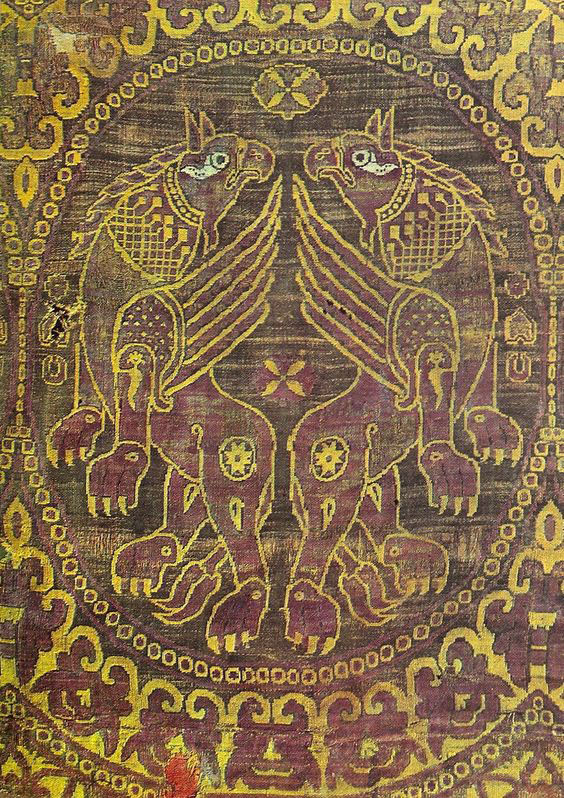 In mosaics he put up in a domed ceiling in his new Blachernae palace Manuel was shown as a military hero, centrally placed, encircled by personifications of virtues who were represented holding hands. A poet described the military nature of the portrait, saying that the virtues 'are guardians of his state', through which Manuel triumphs over 'Dalmatians, Persians, Dacians and every barbarian and faithless race'. He put up new mosaics of his military victories in the Great Palace showing the 'the brave deeds he accomplished against the barbarians'. The defeated Serbian Zupan Stephen Nemanja, who after being brought to Constantinople as an imperial vassal was brazenly shown images which depicted his defeat at Manuel's hands. Benjamin of Tudela, during his visit to Constantinople, observed that in Manuel's palace 'all the wars of the ancients as well as his own wars are represented in pictures'. Manuel wore silk woven with patterns of fierce lions, winged griffins and eagles which expressed his power visually, 'thundering as it were, from heaven' as 'he performs great and wonderful deeds'. It was said that during peacetime he was addicted to the pleasures of the palace, devoting himself to music and feasting, but that he immediately set aside these things when the empire was threatened. Manuel could be lewd and had a quick temper, but he was also eloquent, strong, generous to a fault, and loyal to his friends.
In mosaics he put up in a domed ceiling in his new Blachernae palace Manuel was shown as a military hero, centrally placed, encircled by personifications of virtues who were represented holding hands. A poet described the military nature of the portrait, saying that the virtues 'are guardians of his state', through which Manuel triumphs over 'Dalmatians, Persians, Dacians and every barbarian and faithless race'. He put up new mosaics of his military victories in the Great Palace showing the 'the brave deeds he accomplished against the barbarians'. The defeated Serbian Zupan Stephen Nemanja, who after being brought to Constantinople as an imperial vassal was brazenly shown images which depicted his defeat at Manuel's hands. Benjamin of Tudela, during his visit to Constantinople, observed that in Manuel's palace 'all the wars of the ancients as well as his own wars are represented in pictures'. Manuel wore silk woven with patterns of fierce lions, winged griffins and eagles which expressed his power visually, 'thundering as it were, from heaven' as 'he performs great and wonderful deeds'. It was said that during peacetime he was addicted to the pleasures of the palace, devoting himself to music and feasting, but that he immediately set aside these things when the empire was threatened. Manuel could be lewd and had a quick temper, but he was also eloquent, strong, generous to a fault, and loyal to his friends.
He came from a large family of 4 boys and 4 girls, where Manuel was the youngest son. Two of his older brothers died before him and Manuel's father passed over the other boy to succeed him on the throne. His father left him a full Imperial treasury along with the crown.
He was unfortunate in the wife his parents selected for him. Choniates tells us:
"The emperor took a wife from a distinguished and most illustrious German family. She was not so much concerned with physical beauty as with her inner beauty and the condition of her soul. Disdaining face powder, eye liner, and eyeshadow underneath the eye, and rouge instead of nature's flush, and ascribing such aids to silly women, she was adorned by the virtues to which she was devoted. She had the natural trait of being unbending and opinionated. Consequently, the emperor was not very attentive to her, but she shared in the honors, bodyguard, and remaining imperial splendors; in matters of the bed, however, she was wronged."
Manuel spent great sums of money on the Bukoleon Palace and added new halls to the so-called Great or Sacred Palace which covered about a quarter of the city (around 20 acres) of Constantinople from the Sea of Marmora to the Golden Horn. The Great palace had been established by Constantine the Great, the founder of the city. He built a huge complex of pavilions, colonnades and reception rooms in Roman style following the the steps of recent emperors, Diocletian at Split and Galerius in Thessalonki. This was a rushed building project, Constantine was eager to turn the ancient Greek city of Byzantium into his new glittering capital and there was much to be done.
Constantinople has always been plagued with earthquakes and they soon started to wreck havoc with Constantine's new buildings, including the palace. New brick and stone work - along with the soaring vaults and domes of the palace were easily damaged by tremors.
Surprisingly there were just a few churches in the new palace which was designed to accommodate civil and Imperial ceremonies. Constantine's new city had its own senate patterned on Rome's old one and a large civil bureaucracy to run the city and the Empire. There were many new immigrants to Constantinople.
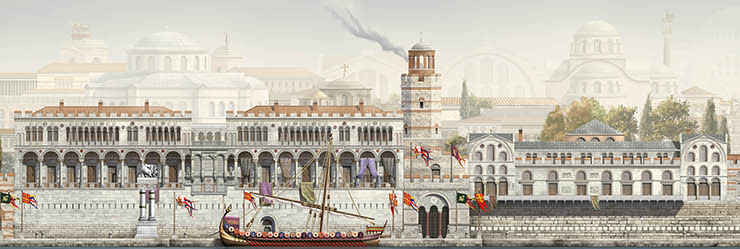 In the 12th century, in the time of Manuel I the population of Constantinople had increased to around 600,000 - rivaling Justinian's era, just before the Black Plague wiped out 50% or more of its inhabitants. At the same time the economy had expanded dramatically, mostly generated by several decades of peace in the regions around the city. The farms of Thrace and Bithynia poured foodstuffs into the city and even produced surpluses for trade. Merchant ships moved from port to port buying them up and selling them in cities along their way. Constantinople was a city-state that prospered when its immediate hinterland did, there may have been a period of exceptional positive climate conditions that increased yields of grain and oil. The seas around the city were always the primary source of protein for the city, its fishermen delivered tons of fresh seafood to its docks every day from hundreds of boats. Vegetables and fruits were grown in the city and outside the walls, producing more than the city could consume. Bread was a staple of the daily menu that was milled and then baked in large commercial operations. Bread and fish were the essentials that kept the city going.
In the 12th century, in the time of Manuel I the population of Constantinople had increased to around 600,000 - rivaling Justinian's era, just before the Black Plague wiped out 50% or more of its inhabitants. At the same time the economy had expanded dramatically, mostly generated by several decades of peace in the regions around the city. The farms of Thrace and Bithynia poured foodstuffs into the city and even produced surpluses for trade. Merchant ships moved from port to port buying them up and selling them in cities along their way. Constantinople was a city-state that prospered when its immediate hinterland did, there may have been a period of exceptional positive climate conditions that increased yields of grain and oil. The seas around the city were always the primary source of protein for the city, its fishermen delivered tons of fresh seafood to its docks every day from hundreds of boats. Vegetables and fruits were grown in the city and outside the walls, producing more than the city could consume. Bread was a staple of the daily menu that was milled and then baked in large commercial operations. Bread and fish were the essentials that kept the city going.
Many of the farms and most of commercial ventures in the city were owned by either the Imperial court or the one of the great churches and monasteries. There were 20,000 or more civil employees who worked for the site, most of these activities were centered within the grounds of the Great Palace. Most state employees were catered their meals on the job in the palace, where there were kitchens and bakeries working non-stop to feed them and the courtiers attached to the court itself. There were also several thousand members of the Imperial guards who were fed by the state and a large number of them were housed in barracks within the gates of the Great Palace. All of these people not only ate but they drank large amounts of wine and beer everyday.
The Emperor hosted many banquets in the palace for hundreds of guests who set at long tables set with silver dishes, glasses for wine, table clothes and linen napkins. Even though he was the host, an Emperor never ate with his subjects and only watched them from raised platform. the diners would usually chant cheers for the emperor before being served and they were entertained by musicians, jugglers and dancers. Sometimes guests were allowed to take their silver plates with them after dinner had concluded. Most of the time low level officials were served on ceramic plates.
An important part of a bureaucrat's compensation was in the form of bulk foodstuffs - like grain and oil - that was delivered monthly. What you didn't use at home could be resold. The churches and monasteries distributed a large part of their food and grain to the poor.
At the very top of the food-chain was the Emperor and his close circle of family, friends and elite servants. Manuel, like his father before hm, awarded his family with gifts of farms and villages to supply them directly with produce and revenue from what they did not consume themselves. They wanted to be as independent of him as they could and Manuel did not want to be burdened with petty family issues like food and housing. Within Manuel surrounded himself with circle of intimate personal friends, most of them came from his early days in the military traveling around the borderlands of the empire with his brothers and father, fighting the enemies of the empire. Many of the men he met were foreigners of Turkish, Arab and Crusader origin. Some of them came as hostages or enlisted in the army and became converts to Christianity from Islam. Manuel instinctively liked the Frankish and Norman soldiers who had settled in Antioch and the Holy Land. He learned their language and customs, his father John II had intended him to rule a new Byzantine-Frankish kingdom he would establish in the borderlands of Byzantium. With that in mind he encouraged to Manual to learn Frankish and establish personal relationships with the lords of Crusader east and their families.
Manuel attempted to forge personal relations with the Turkish Islamic dynasts of the East with less success. He brought them as guests into the palace and spend huge sums of money entertaining them there. Manuel even learned Turkish and had a sincere sympathy for their religion. To the horror of the Crusaders who visited the city Constantinople had a large mosque and regular Islamic services.
In 1162 Manuel made the serious mistake of trusting the Turkish Sultan Arslan and deluding himself that their personal friendship was something more than what it was:
"Manuel, who knew that no barbarian is able to resist the temptation of gain, wished to magnify himself and to astound Kilij Arslan with the immense riches of the treasuries which overflowed on all sides of the Roman empire, and thus he displayed all the gifts which he proposed to offer the sultan in one of the palace's splendid men's apartments. These consisted of gold and silver coins, luxuriant raiment, silver beakers, golden Theriklean vessels, linens of the finest weave, and other choice ornaments which were easily procured by the Romans but rare among the barbarians and hardly ever seen by them. On entering the men's apartments to which he had summoned the sultan, the emperor inquired if he wished to receive as gifts the contents of the treasury at hand. When the sultan replied that he would take whatever the emperor offered him, the emperor posed a second question, asking if any of the enemies of the Romans could possibly withstand their assault should he pour such treasures on mercenary and native troops."
"Seized with wonder and answering that were he the master of such vast sums of money he would have subjugated his enemies long ago, the emperor said, "I present you with all these treasures so that you may know my generosity and munificence and that he who is lord over such wealth is he who grants so much to one man." The sultan was delighted and astonished at the outpouring of money and, blinded by the desire of gain, promised to hand over Sebasteia and its lands to the emperor. Manuel gladly welcomed this promise and agreed to give him more money should he confirm his words by deeds."
When the Sultan arrived in the city he was personally escorted by Manuel, who received the sultan wearing a specially made garment, a purple robe on which a "meadow" was embroidered in rubies and pearls, supposedly an Islamic motif the Sultan would appreciate. Arslan visited the city for 80 days, attending a triumph as well as races and other festivities in his honor held in the Hippodrome. Manuel had planned to show the Sultan Hagia Sophia but an earthquake shook the city and it was called off. A treaty was concluded whereby the emperor ritually adopted the sultan as his son and undertook to subsidize his wars against his Turkish rivals; in return, any important cities recovered from the latter were to be surrendered to the emperor, and the sultan promised to prevent raids on the empire’s territories.
Manuel also hosted Almaric, the Frankish King of Jerusalem, in 1171 in both the Great and Blachernae palaces. During his visit he was shown all of the wonders and treasures within and outside of the walls of the city. He most certainly would have seen the trained bears who played musical instruments. Almaric, a tall blond man who was very fat, had married into the Komnenian family in 1167 and was now a relation of his. The Frankish King would have presented a strong physical contrast to Manuel, who was also tall, but very muscular and swarthy in appearance. Almaric had two children with Maria Komnene, the emperor's grandniece, before he died in 1174 when he was just 38.
The only person who was allowed to ride a horse through the main gate of the place was the emperor, everyone else had to dismount and walk from there. Manuel had splendid Arabian stallions and several hundred of them were kept in sables here. His horses were dressed in beautiful ornaments and had tinkling bells in their long manes. They had their own pastures just outside of the walls of the city, thousands of acres of sweet grasslands. It was quite a sight to see the emperor's horses, splendidly dressed in livery, being led through the streets through the Golden Gate and out to pasture. Byzantine men - merchants, doctors and aristocrats - all aspired to be seen riding fine horses around the city. Women and priests - even the Patriarch - rode mules, which were also used for the transport of the court's baggage.
There was a system of Imperial mail that delivered documents and messages throughout the city and its suburbs. The advent of cheaper paper increased the volume considerably. Perhaps 100 scribes were employed as full-time copiers of imperial proclamations. They also copied letters Manuel would send to correspondents and administrators around the empire. When he traveled he issued an Imperial newsletter on current events which was sent to Constantinople. It was the responsibility of the clergy of Hagia Sophia - the first recipient of it - to read it from the ambo of the cathedral to the public. This imperial communications department also posted announcements and proclamations in the forums and public places. Churches, all priests had to read and write, were responsible to communicate news in their local neighborhoods.
In the palace Manuel had a series of semi-public and private chambers he lived in. They were situated in the palace based on light, ventilation and privacy. The imperial family was always trying to separate themselves from the public activities that took place in and near their residence. One emperor, Nikephorus Phocas, built a special wall within the palace to defend himself. The public didn't like it because the wall cut them off from a couple of popular churches. It didn't help Nikephorus in the end, he was assassinated by his wife's lover in his bedroom. His killers had climbed up ropes to get at him.
One cannot over-estimate the luxury and extravagance of those rooms. There was certainly nothing like them anywhere in Western Europe, at the time, perhaps only the Chinese court surpassed them. His rooms were decorated with marble columns, sculpture and colored wall revetments while the floors were set with geometric patterns in opus sectile marble tiles. The vaults and walls were encrusted with gold, glass and stone mosaics which featured arabesques entwined with mythological animals and told stories of his military exploits. These chambers would have been furnished with intricately carved wooden furniture including chairs, cupboards and beds covered in silks and tapestries. Windows were set with shutters that were set with panes of clear and colored glass. Silk curtains embroidered in gold were hung across doorways and between columns. Dozens of colored and gilded glass lamps set in brass chandeliers hung from gilt-bronze brackets burning fragrant oils. Desks and tables had their own lighting for reading. Aromatic woods and perfumes were burned in braziers and silver basins, the floors were strewn with myrtle, rosemary and grape leaves.
Manuel had a huge wardrobe that moved with him from palace to palace and followed him when he was on a military campaigns. Every year the Imperial workshops and leading commercial stores produced textiles, clothing, jewelry and perfumes for the court as standing orders. The patronage of the court was the life-blood of the luxury industries of Constantinople and generations of orders enabled them to maintain their expertise in making things like fine silks, gold enamels and jeweled regalia. These were not only for Manuel's personal use, they were given by him as gifts. When he traveled he brought lots of things to give to people he met along the way. He also sent gifts to other male rulers. One of the most appreciated were gifts of fine linen towels and under garments that were embroidered in real gold thread.
Merchants brought their best wares to the palace were they were previewed by court officials. The very best were sent on to Manuel to choose from. Things like linens and clothing were arranged and priced by their level of quality. Through his agents Manuel made special commissions for important gifts to churches and monasteries. He also ordered art for his palaces and made gifts of his portrait all over the city. His friends and relatives put up mosaic portraits of him in and outside their palaces as public demonstrations of their loyalty and closeness to him.
In the Great Palace Manuel had dozens of servants that dressed him and took care of his clothes and other personal possessions. His servants were both male and female, many of the men were eunuchs. Female servants were criticized as being sources of bad advice. Unlike the court of Louis XVI the privilege of dressing the monarch did not go to the most senior members of the court. All of his servants were civilians that had positions in the bureaucracy and were paid established salaries and sometimes received personal bonuses from the Emperor. Their uniforms were established by court regulation and supplied to them when they arrived for work. Their uniforms were made of fine materials like silk, top-quality linen and sometimes wool. There were special uniforms that were only worn at Holidays like Easter. Servants in uniform joined the many long processions that regularly filed the streets of Constantinople on special holidays and celebrations, where they would sing and chant accolades for their rulers like cheerleaders. Uniforms were were stored in a warren of closets underneath the palace. They were maintained and cleaned by palace tailors and professional cleaners. Uniforms could be used over many decades. Servants followed established requirements for grooming and cleanliness, bathing regularly. All Byzantine palaces had extensive baths for servants and courtiers. The best were reserved for the Emperor and his friends. Constantinople was surrounded by great forests of wood for the stoves of these baths. Water was becoming a problem and Manuel I was developing better sources from the west of the city. Huge quantities of new water were brought into the city under the walls near the Blachernae Palace. Manuel died before he was able to finish the transportation of water across the city from there to the Great Palace.
Water was very important for sanitation in the Great Palace. Manuel was especially concerned about this after he had a son and heir with this second Frankish wife Maria of Antioch. He and his family had to move around within the Great Palace to different wings - and even flee to Blachernae - when parts of the palace became smelly. The Byzantines knew nothing of bacteria and judged the safety of rooms in the palace by their smell. Today we know the palace became infected with typhoid from dirty drains and polluted water sources. Who knows how many people died of it.
Byzantine doctors were highly skilled, Manuel's top doctor was a Jew. Manuel fancied himself a doctor, he had directed field hospitals when on campaign and even set broken bones and mended wounds with his own hands. His medical experience extended to the mixing and applications of medicines, which he made himself and forced on his friends and family. Although this might suggest Manuel had a scientific, fact based intellect he dabbled dangerously in astrology and the black arts, which alarmed the church. He planned major events and decisions on astrology and believed in the fantastic predictions of seers and wizards. He had been told the first letters of the names of his grandfather, father and himself - A I M must be followed by an A - so he named his son A - Alexis. When he died in 1180 he didn't believe he was facing death because his astrologers had told him he had 14 more years of life left to reign. Therefore he made no arrangements for his succession and left chaos behind him.
Manuel managed to live a private life within the Great Palace surrounded by servants and priests. There were many private entrances and hidden corridors within the palace where you could smuggle people in. Manuel had a serious problem, a sexual addiction, which must have been begun when he was a teenager and was introduced to women on campaign with his dad. Women; wives, girl friends and prostitutes - thousands of them - followed in the wake of the Byzantine army. Some of them would have been beautiful, high-class courtesans attached to the officer corps. These women could have been well-educated and might have been even selected for Manuel to introduce him to sexuality. Later, Manuel had many mistresses, including his own niece, Theodora, who he had a daughter with. It was thought his face bore the marks of sexual dissolution on it. When he was emperor Manuel was able conduct his sexual affairs within the palace and his close circle of friends. It is hard to imagine what the church must have thought of this. It was not as bad as consorting with astrologers but it he was a married man. He had a difficult time securing male heir, in part because he was sowing his wild oats with any women who was not his wife. It must of occurred to Manuel that he was cursed because of his sexual sins and that was the reason he could not get an heir.
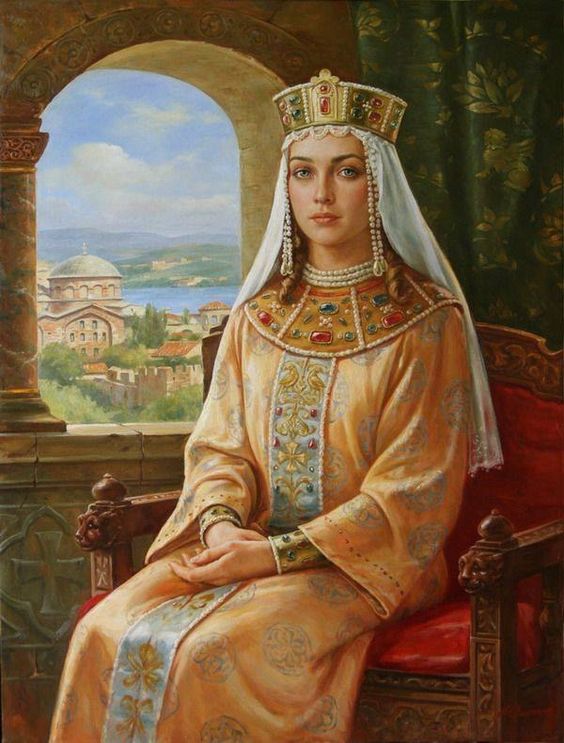 It was commonly believed that the palace was full of loose women who debauched the Emperor with their beauty and seductiveness. You could see women in the palace from the city watching the nearby streets and forums from windows and terraces above. One can imagine the stories that were told about them and what went on in the palace between Manuel and his niece Theodora. It was said that she refused to visit Manuel in the palace unless it had just been thoroughly cleaned and swept out for her. She loved to stir things up in advance of her arrival and see the effect of her power over the servants. People said he handed over vast sums of money to the illegitimate son she bore him. It is amazing that in such a religious society, Manuel and Theodora managed to get away with their relationship without the censure of the church.
It was commonly believed that the palace was full of loose women who debauched the Emperor with their beauty and seductiveness. You could see women in the palace from the city watching the nearby streets and forums from windows and terraces above. One can imagine the stories that were told about them and what went on in the palace between Manuel and his niece Theodora. It was said that she refused to visit Manuel in the palace unless it had just been thoroughly cleaned and swept out for her. She loved to stir things up in advance of her arrival and see the effect of her power over the servants. People said he handed over vast sums of money to the illegitimate son she bore him. It is amazing that in such a religious society, Manuel and Theodora managed to get away with their relationship without the censure of the church.
The city government licensed brothels, we know some of them were located near the forum of Constantine right in the center of the city. The brothels were world famous and one of the top attractions for male visitors, like crusader soldiers and merchants. As a private trade prostitution was widespread among widows who operated out of their homes and apartments.
The Great Palace was built between the hippodrome and the sea. Millions of court documents were stored in the chambers beneath the seats. There was a trained staff who maintained them. They had filing system that enabled them to locate any document you were looking for. The Byzantines conducted all of their business with contracts that were maintained in duplicate, you kept yours and the other went to the archives. Church archives were kept at Hagia Sophia. Documents were written on parchment or paper and were set with lead seals. Tens of thousands of these lead seals have survived while their documents have perished.
Courts of law and the imperial Chrysioplysia mint was also located in the Great Palace. Once during riot the mob managed to break into the mint and loot it, not stopping there they even stole the precious covering from the Mandylion in the Pharos church:
"...(besides the raw metals which had not been coined, there were twelve hundred pounds of gold, three thousand pounds of silver, and twenty thousand pounds of copper coins) and whatever else they could lay their hands on and carry away either individually or with the help of many others. Entering the armories, they removed countless weapons. They proceeded to despoil the churches inside the palace and went so far as to pull the ornaments off the holy icons and to make away with the most sacred wrapping in which, according to an ancient tradition which has been handed down to us, was folded the letter of the Lord written in his own hand to Abgar.'"
Courts were held not only in the palace, but in various places throughout the city. There was a state prison within the grounds of the palace which was close to the barracks of the Imperial guard. The palace guards units were quartered where they always had been, just inside the main entrance on the northern side.
Finding the existing halls of the Great Palace inadequate to express his own glory, Manuel built a huge new throne room decorated with mosaics depicting himself and Christ in the apse.
The Imperial birthing chamber, the Porphrya, was renovated and made ready for the birth of his son Alexios, who was born by his second wife in 1169. The birth was accompanied by great feasts for the entire city and heralded by Ethiopian and Latin trumpeters blowing silver trumpets from the steps of the palace.
When Alexios was engaged to a French princess in 1180, one of the oldest parts of the Great Palace, the Trullian or Troulos Hall, was used for the ceremony. This tells us parts of the palace built by Constantine the Great and his successors were still in use 800 years after they were built. It was a huge structure - Troulos means domed in Greek. In a church council of 692, during the reign of Justinian II, more than 200 bishops were seated in it. You can read an English translation of the canons of the council by clicking here. After so many years of earthquakes it is remarkable that it still stood and was in a good enough condition to be used for such an important ceremony. Manuel probably had it renovated expressly for it
Manuel held several important church councils in the Great and Bukoleon Palaces. He moved them here from Hagia Sophia so he could house the attendees as his guests in the palace (showering them with gifts and attention) and influence their decisions. If a council was held in Hagia Sophia the catering would have been done by the Patriarch. Manuel considered himself a master theologian and believed the Emperor had the right to participate and direct religious debate like this. The Emperor had personal relationships with many bishops and the clergy of Hagia Sophia. He insisted on discussing theology with them, which was in itself dangerous and alarming. Manuel believed they accepted him as equals when such a thing was not possible. He loved to give expensive gifts and thought this made people like him for his generosity. He could not distinguish between sincere gratitude and servility or chose not to see the difference.
Manuel, like his father before him, believed God spoke to him and directed his actions. Manuel believed his name - E-manuel - indicated a mystical connection to Christ himself. He was described by the poet Manganeios Prodromos, as "an imitator of Emmanuel, the new Alexander, Christian and greater than Alexander, for having terrified and defeated all enemies".
He built few churches. Within the Great Palace the most important was the famous Church of the Pharos Lighthouse where the greatest of Christianity's relics were housed. When King Louis VII of France and his wife Eleanor of Aquitaine visited Manuel in Constantinople this chapel was their number one destination on their tour of the city. It was located just behind the Palace of the Boukoleon. It was one of the great landmarks of the city that sailors and travelers saw as their ships rounded the corner of the sea walls enroute to the harbor of the Golden Horn. After the Fourth Crusade another King of France would buy the relics in this church from the Latin Emperors and take them to Paris where the newly built Sainte-Chapelle awaited them.
The crusader Robert of Clari - who saw the chapel described it:
"More–over, there were full thirty chapels there, both large and small; and there was one of these which was called the Holy Chapel, that was so rich and so noble that it contained neither hinge nor socket, nor any other appurtenance such as is wont to be wrought of iron, that was not all of silver; nor was there a pillar there that was not of jasper or porphyry or such like rich and precious stone. And the pavement of the chapel was of white marble, so smooth and so clear that it seemed that it was of crystal. And this chapel was so rich that one could not describe to you the great beauty and the great magnificence thereof. Within this chapel were found many precious relics; for therein were found two pieces of the True Cross, as thick as a man’s leg and a fathom in length. And there was found the lance wherewith Our Lord had His side pierced, and the two nails that were driven through the midst of His hands and through the midst of His feet. And there was also found, in a crystal phial, a great part of His blood. And there was found the tunic that he wore, which was stripped from Him when He had been led to the Mount of Calvary. And there, too, was found the blessed crown wherewith He was crowned, which was wrought of sea rushes, sharp as dagger blades. There also was found the raiment of Our Lady, and the head of my Lord Saint John Baptist, and so many other precious relics that I could never describe them to you or tell you the truth concerning them."
Manuel had a famous relic from Ephesos, the stone on which Christ had been laid, brought to the harbor of the Great Palace and then carried it on his back up the marble stairs leading from the dock and into the Pharos Church:
"He was buried beside the entrance to the church of the Monastery of the Pantokrator, not in the temple itself but in the shrine attached to it. Where the church wall led round to an arch, a broad entrance way was opened around the sepulcher, which was faced with marble of a black hue, gloomy in appearance, and was divided into seven lofty sections. To the side, resting on a base, was a slab of red marble the length of a man which received veneration; it was formerly located in the church of [St. John the Evangelist] Ephesos and was commonly reported to be that on which Christ was washed with myrrh and wrapped in burial linen clothes after he had been taken down from the cross. This emperor had it taken out of the church, and, placing it on his back, he carried it up from the harbor of Boukoleon to the church in the lighthouse of the palace [Pharos]... as though it were the actual body of God conveying its grace on him. Not long after the emperor's death, the marble slab was removed from the palace to the place described above with proclamations, I believe, that declared loudly all the feats for which he who lay silent in the tomb had labored and struggled so hard to achieve."
While some areas of the Great Palace had mowed grass, flowers and clipped hedges, other parts were overgrown with tall weeds and impassable brambles like wild roses. One could hide in the tall grasses. The emperors had zoos with captive beasts like lions and giraffes. Cheetahs were kept as pets and used in hunting. Alexis, Manuel's grandfather, kept a pride of lions in a big open space between the walls surrounding the Blachernae Palace. One of the lions was old and toothless, he became one of Alexis's favorite pets. In 1101 a Lombard army of the First Crusade was camped outside the walls. Nancy Sevcenko relates the following:
"...Emperor Alexios I Komnenos at first dismissed the problem of this rowdy and obstreperous group that was clamoring for provisions and refusing to move on. “But when he realized that they were persisting in their efforts, he commanded that three fierce lions and seven leopards (“tres ferocissimos leones et septem leopardos”) should be driven between the middle and outer walls. He also posted guards on the third wall, against which the palaces of the nobility were built, and commanded that the gates be barred. So, derisively, he proposed to frighten away the westerners with wild beasts, and defend the imperial city without human force. ”When the Franks broke through the outer gate, “instantly the fierce lions sprang on the first men to enter and injured some whom they savaged with teeth and claws, tearing men who were caught unawares and had no experience of fighting wild animals. But the attack of beasts could not defeat the wit of man for long. Armed champions sent spears and javelins whistling to strike down the wild animals and after killing the lions drove away the leopards, chasing them as they fled up to the middle wall. Then the leopards, creeping forward like cats, leapt over the wall, and the troops of westerners entered through the gate in the second wall and attempted to take the third by assault.” According to a third source, Albert of Aachen, in the course of this raid on the palace the Lombards also killed the emperor’s pet lion, which had been kept as a friend in the palace."
These lions were brought to the hippodrome for wild beast fights where they were released to attack bulls.
Manuel was active sportsman and regularly played on the polo grounds of the Great Palace. His body as covered with scars from games like these. Manuel even performed western-style jousts. He also was a huntsman. When King Louis of France visited him he had the French royals put up in the hunting palace of Philopation, just outside of the walls of Blachernae. The palace was set in the middle of rolling grass-covered hills with plenty of wild boar to hunt.
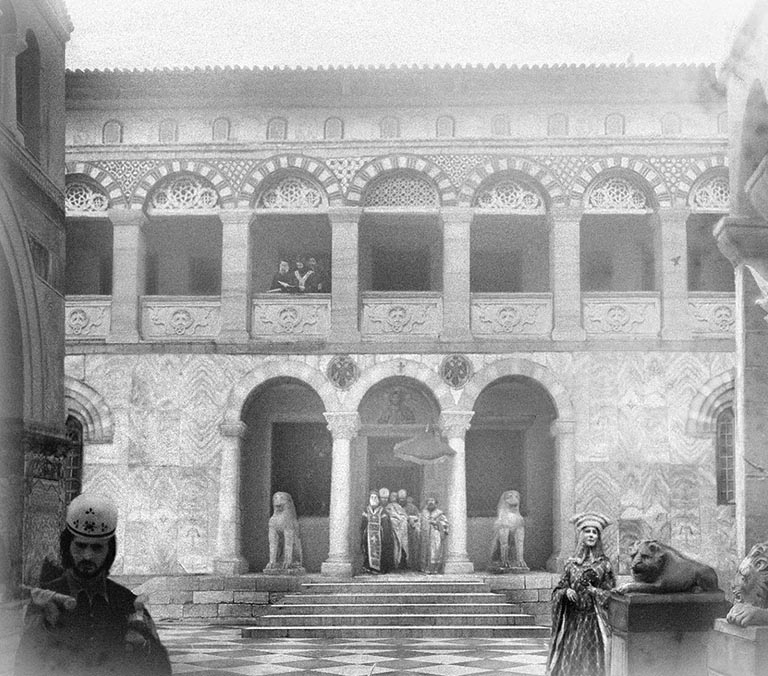
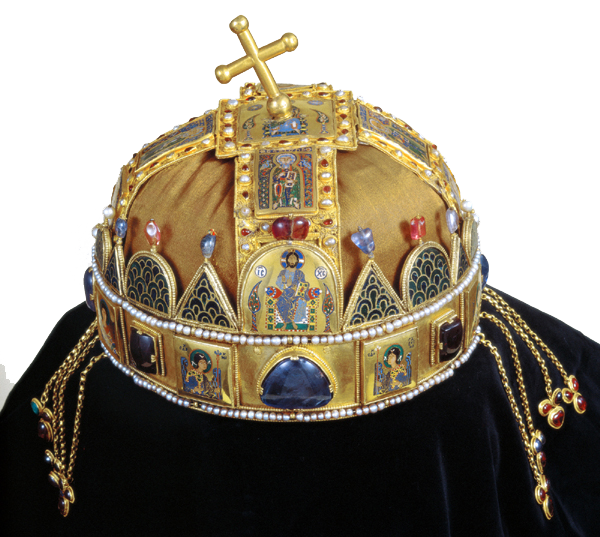
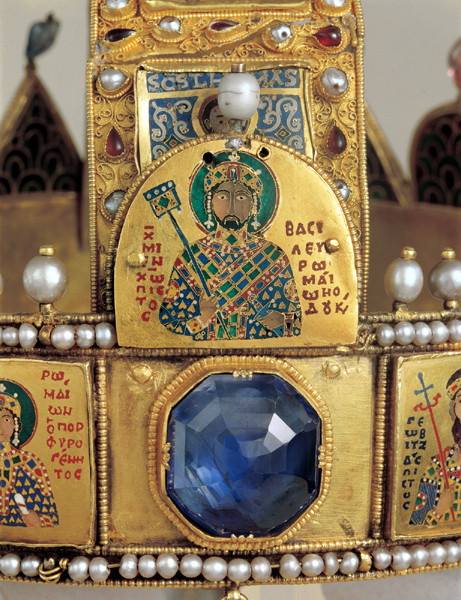
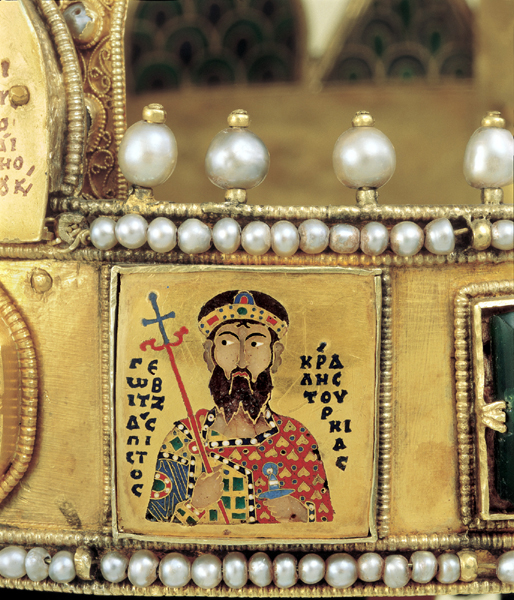
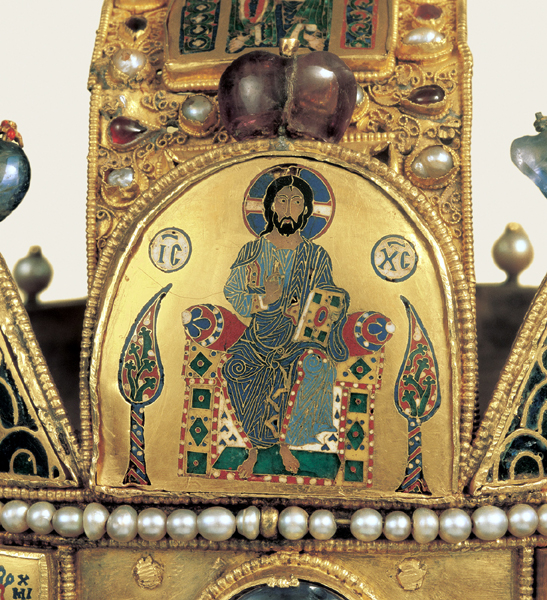
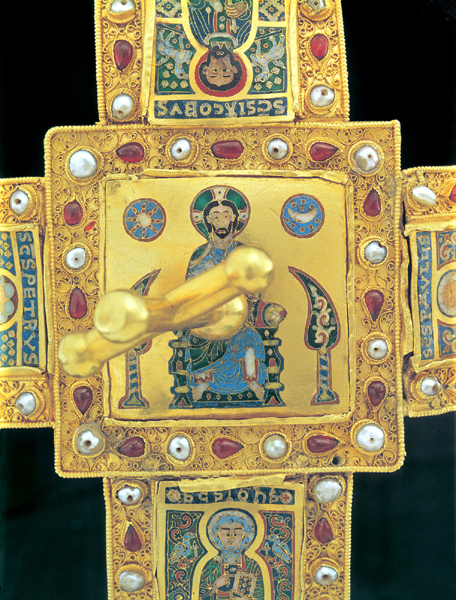
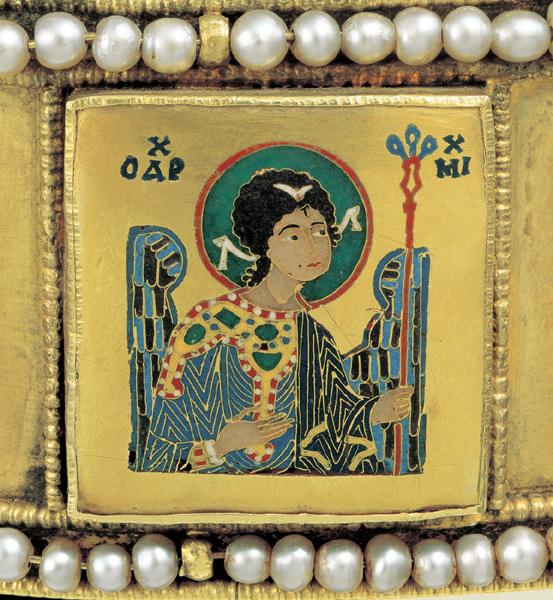
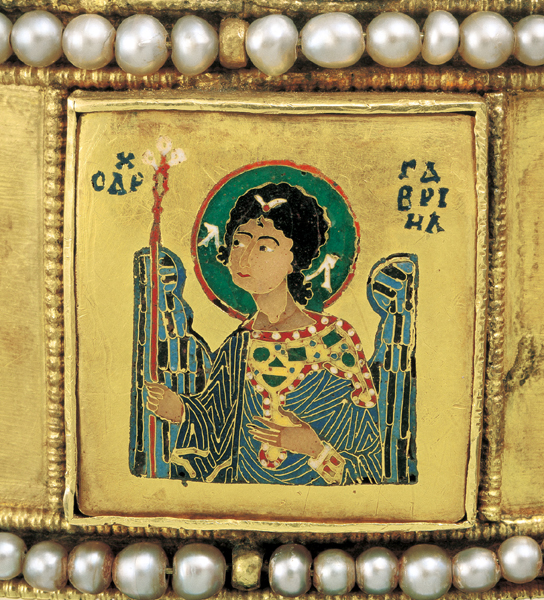
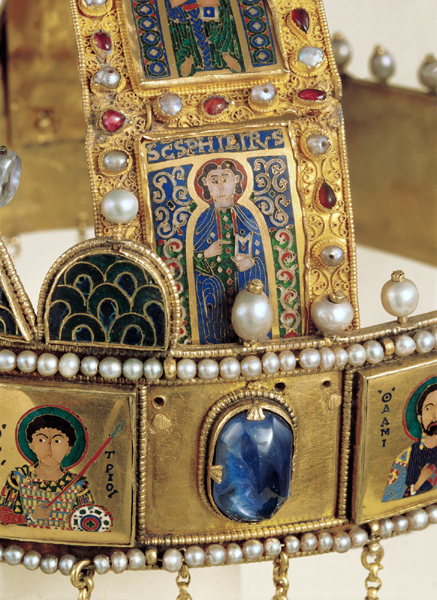
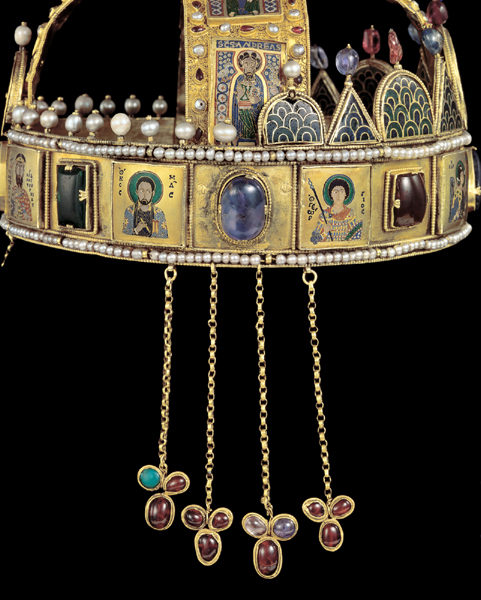
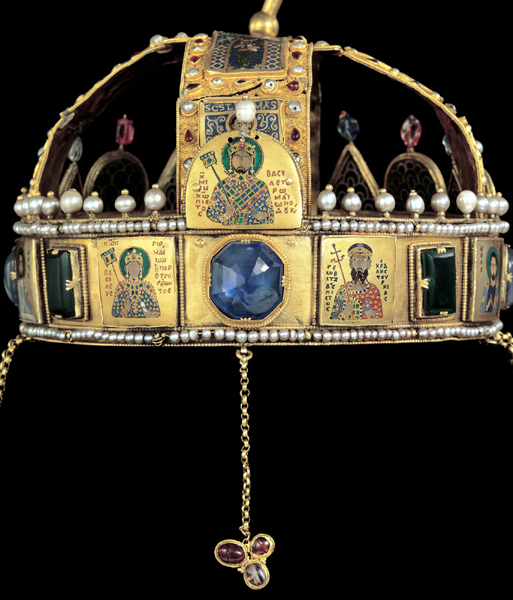

 There were two areas within the walls of the city that were filled with Imperial palaces. The smallest was located in the northwest corner of the city between the
There were two areas within the walls of the city that were filled with Imperial palaces. The smallest was located in the northwest corner of the city between the  In mosaics he put up in a domed ceiling in his new Blachernae palace Manuel was shown as a military hero, centrally placed, encircled by personifications of virtues who were represented holding hands. A poet described the military nature of the portrait, saying that the virtues 'are guardians of his state', through which Manuel triumphs over 'Dalmatians, Persians, Dacians and every barbarian and faithless race'. He put up new mosaics of his military victories in the Great Palace showing the 'the brave deeds he accomplished against the barbarians'. The defeated Serbian Zupan Stephen Nemanja, who after being brought to Constantinople as an imperial vassal was brazenly shown images which depicted his defeat at Manuel's hands.
In mosaics he put up in a domed ceiling in his new Blachernae palace Manuel was shown as a military hero, centrally placed, encircled by personifications of virtues who were represented holding hands. A poet described the military nature of the portrait, saying that the virtues 'are guardians of his state', through which Manuel triumphs over 'Dalmatians, Persians, Dacians and every barbarian and faithless race'. He put up new mosaics of his military victories in the Great Palace showing the 'the brave deeds he accomplished against the barbarians'. The defeated Serbian Zupan Stephen Nemanja, who after being brought to Constantinople as an imperial vassal was brazenly shown images which depicted his defeat at Manuel's hands.  In the 12th century, in the time of Manuel I the population of Constantinople had increased to around 600,000 - rivaling Justinian's era, just before the Black Plague wiped out 50% or more of its inhabitants. At the same time the economy had expanded dramatically, mostly generated by several decades of peace in the regions around the city. The farms of Thrace and Bithynia poured foodstuffs into the city and even produced surpluses for trade. Merchant ships moved from port to port buying them up and selling them in cities along their way. Constantinople was a city-state that prospered when its immediate hinterland did, there may have been a period of exceptional positive climate conditions that increased yields of grain and oil. The seas around the city were always the primary source of protein for the city, its fishermen delivered tons of fresh seafood to its docks every day from hundreds of boats. Vegetables and fruits were grown in the city and outside the walls, producing more than the city could consume. Bread was a staple of the daily menu that was milled and then baked in large commercial operations. Bread and fish were the essentials that kept the city going.
In the 12th century, in the time of Manuel I the population of Constantinople had increased to around 600,000 - rivaling Justinian's era, just before the Black Plague wiped out 50% or more of its inhabitants. At the same time the economy had expanded dramatically, mostly generated by several decades of peace in the regions around the city. The farms of Thrace and Bithynia poured foodstuffs into the city and even produced surpluses for trade. Merchant ships moved from port to port buying them up and selling them in cities along their way. Constantinople was a city-state that prospered when its immediate hinterland did, there may have been a period of exceptional positive climate conditions that increased yields of grain and oil. The seas around the city were always the primary source of protein for the city, its fishermen delivered tons of fresh seafood to its docks every day from hundreds of boats. Vegetables and fruits were grown in the city and outside the walls, producing more than the city could consume. Bread was a staple of the daily menu that was milled and then baked in large commercial operations. Bread and fish were the essentials that kept the city going. It was commonly believed that the palace was full of loose women who debauched the Emperor with their beauty and seductiveness. You could see women in the palace from the city watching the nearby streets and forums from windows and terraces above. One can imagine the stories that were told about them and what went on in the palace between Manuel and his niece Theodora. It was said that she refused to visit Manuel in the palace unless it had just been thoroughly cleaned and swept out for her. She loved to stir things up in advance of her arrival and see the effect of her power over the servants. People said he handed over vast sums of money to the illegitimate son she bore him. It is amazing that in such a religious society, Manuel and Theodora managed to get away with their relationship without the censure of the church.
It was commonly believed that the palace was full of loose women who debauched the Emperor with their beauty and seductiveness. You could see women in the palace from the city watching the nearby streets and forums from windows and terraces above. One can imagine the stories that were told about them and what went on in the palace between Manuel and his niece Theodora. It was said that she refused to visit Manuel in the palace unless it had just been thoroughly cleaned and swept out for her. She loved to stir things up in advance of her arrival and see the effect of her power over the servants. People said he handed over vast sums of money to the illegitimate son she bore him. It is amazing that in such a religious society, Manuel and Theodora managed to get away with their relationship without the censure of the church.


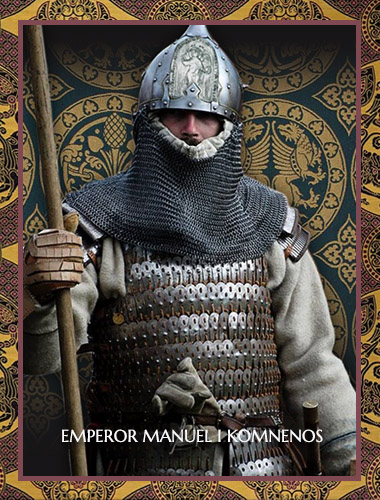

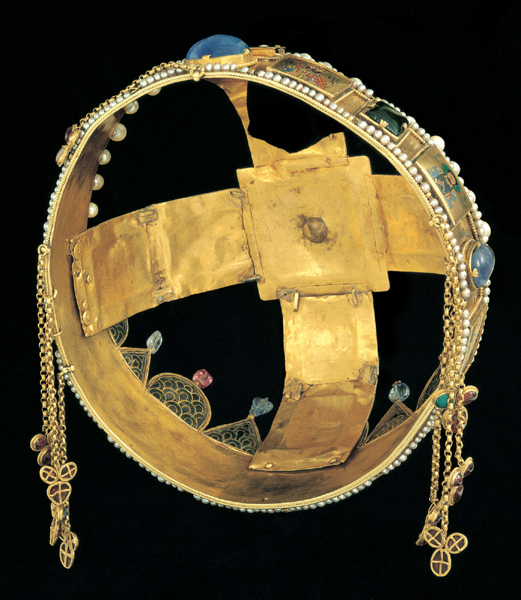
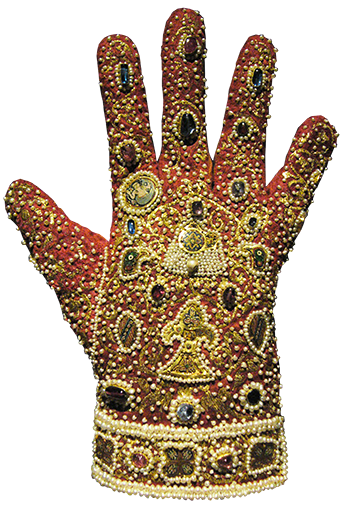
 click here for icons of christ
click here for icons of christ click here for icons of the theotokos
click here for icons of the theotokos click here for icons of angels
click here for icons of angels click here for icons of saints
click here for icons of saints








